Mechanical Behaviour Evaluation of Full Iron Tailings Concrete Columns under Large Eccentric Short-Term Loading
Abstract
1. Introduction
2. Materials and Experimental Design
2.1. Materials
2.2. Experiment Design
3. Experimental Results and Discussion
3.1. Failure Modes and Crack Propagation
3.2. Load–Deflection Relationships
3.3. Deformation and Ductility
3.4. Load–Strain Relationships
4. Analysis of Sectional Capacities
4.1. Moment Magnification Factor
4.2. Bearing Capacity
4.3. Crack-Resistant Load
4.4. Experimental Verification of Theoretical Predictions
5. Conclusions
- Under large eccentric short-term loads, the failure modes of the FITRC and CRC columns were found to be similar, and the failures were manifested by the yielding of the tensile and compressive rebars and concrete crushing in the compression zone. The long-term behaviour of FITRC (creep and shrinkage) requires further investigation.
- As the prismatic compressive and tensile strengths of the FITRC columns were slightly lower than those of the CRC columns, the ultimate load capacity of the FITRC columns was slightly lower than that of the CRC columns, and the crack widths of the FITRC columns were greater than those of the CRC columns.
- The sectional strain of the FITRC columns, which was similar to that of the CRC columns, satisfied the planar section assumption, and the lateral deflection curve agreed well with the half-sinusoidal assumption, which is consistent with the CRC column assumption in the current specifications.
- Compared with the CRC45 and CRC35 columns, the ductility factors of the FITRC45 and FITRC35 columns were 36.6% and 19.5% lower, respectively. The underlying cause of this phenomenon was the comparatively low modulus of elasticity of FITC, which resulted in a more pronounced lateral deformation of the FITRC columns when subjected to eccentric loading than the CRC columns under equivalent conditions.
- Based on the current Chinese standards, the theoretical calculations for the cracking load and ultimate load capacity of FITRC columns are relatively accurate. The calculation results indicate that FITRC columns have a certain safety reserve, and that FITC has the potential for practical application in the construction sector.
- Because the lateral deflection of the FITC columns was greater than that of the CRC columns, the second-order moments of the FITC columns were greater than those of the CRC columns. If the second-order effect is considered in the structural design, the moment augmentation factor of the FITRC columns should be 1.15 for safety reasons. Therefore, FITRC columns with high L/h ratios should be investigated further.
Author Contributions
Funding
Institutional Review Board Statement
Informed Consent Statement
Data Availability Statement
Conflicts of Interest
References
- Maruthupandian, S.; Chaliasou, A.; Kanellopoulos, A. Recycling mine tailings as precursors for cementitious binders—Methods, challenges and future outlook. Constr. Build. Mater. 2021, 312, 125333. [Google Scholar] [CrossRef]
- Zuccheratte, A.C.V.; Freire, C.B.; Lameiras, F.S. Synthetic gravel for concrete obtained from sandy iron ore tailing and recycled polyethyltherephtalate. Constr. Build. Mater. 2017, 151, 859–865. [Google Scholar] [CrossRef]
- Arbili, M.M.; Alqurashi, M.; Majdi, A.; Ahmad, J.; Deifalla, A.F. Concrete made with iron ore tailings as a fine aggregate: A step towards sustainable concrete. Materials 2022, 15, 6236. [Google Scholar] [CrossRef] [PubMed]
- Lv, X.; Lin, Y.; Chen, X.; Shi, Y.; Liang, R.; Wang, R.; Peng, Z. Environmental impact, durability performance, and interfacial transition zone of iron ore tailings utilized as dam concrete aggregates. J. Clean. Prod. 2021, 292, 126068. [Google Scholar] [CrossRef]
- Lv, X.; Shen, W.; Wang, L.; Dong, Y.; Zhang, J.; Xie, Z. A comparative study on the practical utilization of iron tailings as a complete replacement of normal aggregates in dam concrete with different gradation. J. Clean. Prod. 2019, 211, 704–715. [Google Scholar] [CrossRef]
- Zhao, J.; Ni, K.; Su, Y.; Shi, Y. An evaluation of iron ore tailings characteristics and iron ore tailings concrete properties. Constr. Build. Mater. 2021, 286, 122968. [Google Scholar] [CrossRef]
- National Bureau of Statistics; Ministry of Environmental Protection. China Statistical Yearbook on Environment; China Statistics Press: Beijing, China, 2020. [Google Scholar]
- Shettima, A.U.; Hussin, M.W.; Ahmad, Y.; Mirza, J. Evaluation of iron ore tailings as replacement for fine aggregate in concrete. Constr. Build. Mater. 2016, 120, 72–79. [Google Scholar] [CrossRef]
- IFENG. Dam Break Accident in Xiangfen, Shanxi: Who is Responsible for the Disaster? 2008. Available online: https://news.ifeng.com/mainland/200809/0912_17_780544.shtml (accessed on 1 December 2022).
- CHINANEWS. Shanxi Jiaokou Official Response ‘A Tailings Dam Accident’. 2022. Available online: http://www.chinanews.com.cn/sh/2022/04-01/9717734.shtml (accessed on 1 December 2022).
- Ahmari, S.; Zhang, L. Production of eco-friendly bricks from copper mine tailings through geopolymerization. Constr. Build. Mater. 2012, 29, 323–331. [Google Scholar] [CrossRef]
- Kinnunen, P.; Ismailov, A.; Solismaa, S.; Sreenivasan, H.; Räisänen, M.L.; Levänen, E.; Illikainen, M. Recycling mine tailings in chemically bonded ceramics—A review. J. Clean. Prod. 2018, 174, 634–649. [Google Scholar] [CrossRef]
- Zhang, N.; Tang, B.; Liu, X. Cementitious activity of iron ore tailing and its utilization in cementitious materials, bricks and concrete. Constr. Build. Mater. 2021, 288, 123022. [Google Scholar] [CrossRef]
- Zareei, S.A.; Ameri, F.; Bahrami, N.; Shoaei, P.; Moosaei, H.R.; Salemi, N. Performance of sustainable high strength concrete with basic oxygen steel-making (BOS) slag and nano-silica. J. Build. Eng. 2019, 25, 100791. [Google Scholar] [CrossRef]
- Kusuma, G.H.; Budidarmawan, J.; Susilowati, A. Impact of concrete quality on sustainability. Procedia Eng. 2015, 125, 754–759. [Google Scholar] [CrossRef]
- National Bureau of Statistics of China. National Data: Output of Industrial Products in 2021. 2021. Available online: https://data.stats.gov.cn/english/easyquery.htm?cn=C01 (accessed on 1 December 2022).
- Thomas, B.S.; Damare, A.; Gupta, R.C. Strength and durability characteristics of copper tailing concrete. Constr. Build. Mater. 2013, 48, 894–900. [Google Scholar] [CrossRef]
- Sant’Ana Filho, J.N.; Da Silva, S.N.; Silva, G.C.; Mendes, J.C.; Fiorotti Peixoto, R.A. Technical and environmental feasibility of interlocking concrete pavers with iron ore tailings from tailings dams. J. Mater. Civil. Eng. 2017, 29, 04017104. [Google Scholar] [CrossRef]
- Liu, J.; Zhou, Y.; Wu, A.; Wang, H. Reconstruction of broken Si-O-Si bonds in iron ore tailings (IOTs) in concrete. Int. J. Min. Met. Mater. 2019, 26, 1329–1336. [Google Scholar] [CrossRef]
- Tang, C.; Li, K.; Ni, W.; Fan, D. Recovering Iron from iron ore tailings and preparing concrete composite admixtures. Minerals 2019, 9, 232. [Google Scholar] [CrossRef]
- Carvalho Eugênio, T.M.; Francisco Fagundes, J.; Santos Viana, Q.; Pereira Vilela, A.; Farinassi Mendes, R. Study on the feasibility of using iron ore tailing (IoT) on technological properties of concrete roof tiles. Constr. Build. Mater. 2021, 279, 122484. [Google Scholar] [CrossRef]
- Xu, F.; Wang, S.; Li, T.; Liu, B.; Li, B.; Zhou, Y. Mechanical properties and pore structure of recycled aggregate concrete made with iron ore tailings and polypropylene fibers. J. Build. Eng. 2021, 33, 101572. [Google Scholar] [CrossRef]
- Ullah, S.; Yang, C.; Cao, L.; Wang, P.; Chai, Q.; Li, Y.; Wang, L.; Dong, Z.; Lushinga, N.; Zhang, B. Material design and performance improvement of conductive asphalt concrete incorporating carbon fiber and iron tailings. Constr. Build. Mater. 2021, 303, 124446. [Google Scholar] [CrossRef]
- Lv, Z.; Jiang, A.; Liang, B. Development of eco-efficiency concrete containing diatomite and iron ore tailings: Mechanical properties and strength prediction using deep learning. Constr. Build. Mater. 2022, 327, 126930. [Google Scholar] [CrossRef]
- Medjigbodo, S.; Bendimerad, A.Z.; Rozière, E.; Loukili, A. How do recycled concrete aggregates modify the shrinkage and self-healing properties? Cem. Concr. Compos. 2018, 86, 72–86. [Google Scholar] [CrossRef]
- Carrasco, E.V.M.; Magalhaes, M.D.C.; Santos, W.J.D.; Alves, R.C.; Mantilla, J.N.R. Characterization of mortars with iron ore tailings using destructive and nondestructive tests. Constr. Build. Mater. 2017, 131, 31–38. [Google Scholar] [CrossRef]
- Yao, G.; Wang, Q.; Wang, Z.; Wang, J.; Lyu, X. Activation of hydration properties of iron ore tailings and their application as supplementary cementitious materials in cement. Powder Technol. 2020, 360, 863–871. [Google Scholar] [CrossRef]
- Tan, Y.; Zhu, Y.; Xiao, H. Evaluation of the hydraulic, physical, and mechanical properties of pervious concrete using iron tailings as coarse aggregates. Appl. Sci. 2020, 10, 2691. [Google Scholar] [CrossRef]
- Feng, W.; Dong, Z.; Jin, Y.; Cui, H. Comparison on micromechanical properties of interfacial transition zone in concrete with iron ore tailings or crushed gravel as aggregate. J. Clean. Prod. 2021, 319, 128737. [Google Scholar] [CrossRef]
- Zhao, S.; Fan, J.; Sun, W. Utilization of iron ore tailings as fine aggregate in ultra-high performance concrete. Constr. Build. Mater. 2014, 50, 540–548. [Google Scholar] [CrossRef]
- Zhang, W.; Gu, X.; Qiu, J.; Liu, J.; Zhao, Y.; Li, X. Effects of iron ore tailings on the compressive strength and permeability of ultra-high performance concrete. Constr. Build. Mater. 2020, 260. [Google Scholar] [CrossRef]
- Zhang, Z.; Zhang, Z.; Yin, S.; Yu, L. Utilization of iron tailings sand as an environmentally friendly alternative to natural river sand in high-strength concrete: Shrinkage characterization and mitigation strategies. Materials 2020, 13, 5614. [Google Scholar] [CrossRef]
- Mendes Protasio, F.N.; de Avillez, R.R.; Letichevsky, S.; Silva, F.D.A. The use of iron ore tailings obtained from the Germano dam in the production of a sustainable concrete. J. Clean. Prod. 2021, 278, 123929. [Google Scholar] [CrossRef]
- Zhu, Q.; Yuan, Y.; Chen, J.; Fan, L.; Yang, H. Research on the high-temperature resistance of recycled aggregate concrete with iron tailing sand. Constr. Build. Mater. 2022, 327, 126889. [Google Scholar] [CrossRef]
- Chen, Z.; Chen, S.; Zhou, Y.; Zhang, C.; Meng, T.; Jiang, S.; Liu, L.; Hu, G. Effect of incorporation of rice husk ash and iron ore tailings on properties of concrete. Constr. Build. Mater. 2022, 338, 127584. [Google Scholar] [CrossRef]
- Wang, C.; Ni, W.; Zhang, S.; Wang, S.; Gai, G.; Wang, W. Preparation and properties of autoclaved aerated concrete using coal gangue and iron ore tailings. Constr. Build. Mater. 2016, 104, 109–115. [Google Scholar] [CrossRef]
- Ma, B.; Cai, L.; Li, X.; Jian, S. Utilization of iron tailings as substitute in autoclaved aerated concrete: Physico-mechanical and microstructure of hydration products. J. Clean. Prod. 2016, 127, 162–171. [Google Scholar] [CrossRef]
- Cai, L.; Ma, B.; Li, X.; Lv, Y.; Liu, Z.; Jian, S. Mechanical and hydration characteristics of autoclaved aerated concrete (AAC) containing iron-tailings: Effect of content and fineness. Constr. Build. Mater. 2016, 128, 361–372. [Google Scholar] [CrossRef]
- Cheng, Y.; Huang, F.; Li, W.; Liu, R.; Li, G.; Wei, J. Test research on the effects of mechanochemically activated iron tailings on the compressive strength of concrete. Constr. Build. Mater. 2016, 118, 164–170. [Google Scholar] [CrossRef]
- Han, F.; Song, S.; Liu, J.; Huang, S. Properties of steam-cured precast concrete containing iron tailing powder. Powder Technol. 2019, 345, 292–299. [Google Scholar] [CrossRef]
- Han, F.; Luo, A.; Liu, J.; Zhang, Z. Properties of high-volume iron tailing powder concrete under different curing conditions. Constr. Build. Mater. 2020, 241, 118108. [Google Scholar] [CrossRef]
- Yang, M.; Sun, J.; Dun, C.; Duan, Y.; Meng, Z. Cementitious activity optimization studies of iron tailings powder as a concrete admixture. Constr. Build. Mater. 2020, 265, 120760. [Google Scholar] [CrossRef]
- Gu, X.; Zhang, W.; Zhang, X.; Li, X.; Qiu, J. Hydration characteristics investigation of iron tailings blended ultra high performance concrete: The effects of mechanical activation and iron tailings content. J. Build. Eng. 2022, 45, 103459. [Google Scholar] [CrossRef]
- Han, F.; Zhang, H.; Liu, J.; Song, S. Influence of iron tailing powder on properties of concrete with fly ash. Powder Technol. 2022, 398, 117132. [Google Scholar] [CrossRef]
- Cheng, Y.; Huang, F.; Qi, S.; Li, W.; Liu, R.; Li, G. Durability of concrete incorporated with siliceous iron tailings. Constr. Build. Mater. 2020, 242, 118147. [Google Scholar] [CrossRef]
- Cheng, Y.; Yang, S.; Zhang, J.; Sun, X. Test research on hydration process of cement-iron tailings powder composite cementitious materials. Powder Technol. 2022, 399, 117215. [Google Scholar] [CrossRef]
- Zhang, R. Experimental Studies of Influence for Iron Tailings on Carbonation and Frost Resistance of Concrete. Master’s Thesis, Hebei Agricultural University, Baoding, China, 2022. [Google Scholar]
- Yang, M.; Sun, J.; Xu, Y.; Wang, J. Analysis of influence from iron tailings powder on sulfate corrosion resistance of concrete and its mechanism. Water Resour. Hydropower Eng. 2022, 53, 177–185. [Google Scholar]
- Chen, X. Experimental Study on the Mechanical Properties of the Iron Tailing Sand Green Concrete Members. Ph.D. Thesis, Wuhan University of Technology, Wuhan, China, 2017. [Google Scholar]
- Zhang, K. Experimental Research on Axial Compression of Ferrous Mill Tailing Concrete Short Columns. Master’s Thesis, North China University of Science and Technology, Tangshan, China, 2016. [Google Scholar]
- Li, H. Experimental Study on Seismic Bearing Capacity of Iron Tailorite Concrete Column. Master’s Thesis, North China University of Science and Technology, Tangshan, China, 2018. [Google Scholar]
- Ma, X.; Sun, J.; Zhang, F.; Yuan, J.; Meng, Z. Experimental studies and analyses on axial compressive properties of full iron tailings concrete columns. Case Stud. Constr. Mat. 2023, 18, e1881. [Google Scholar] [CrossRef]
- JGJ55-2011; Specification for Mix Proportion Design of Ordinary Concrete. Architecture and Building Press: Beijing, China, 2011.
- GB/T 50081-2019; Standard for Test Methods of Concrete Physical and Mechanical Properties. China Architecture and Building Press: Beijing, China, 2019.
- Yan, P. Experimental study on mechanical behaviour of high performance iron tailing concrete columns. Master’s Thesis, Hebei University of Architecture, Zhangjiakou, China, 2017. [Google Scholar] [CrossRef]
- Lloyd, N.A.; Rangan, B.V. Studies on high-strength concrete columns under eccentric compression. Aci Struct. J. 1996, 93, 631–638. [Google Scholar] [CrossRef]
- Tang, J. Seismic Resistance of Joints in Reinforced Concrete Frames; Southeast University Press: Nanjing, China, 1989. [Google Scholar]
- Wang, L.; Kai-Leung Su, R. Theoretical and experimental study of plate-strengthened concrete columns under eccentric compression loading. J. Struct. Eng. 2013, 139, 350–359. [Google Scholar] [CrossRef]
- ACI 318-14; Building Code Requirements for Structural Concrete and Commentary. American Concrete Institute: Detroit, MI, USA, 2014.
- Li, Y. Experimental and Theoretical Research on Mechanical Behavior of RC Columns with 600MPa Reinforcing Bars. Ph.D. Thesis, Southeast University, Nanjing, China, 2019. [Google Scholar] [CrossRef]
- GB 50010-2010; Code for Design of Concrete Structures. China Architecture and Building Press: Beijing, China, 2010.
- Ge, W.; Chen, K.; Guan, Z.; Ashour, A.; Lu, W.; Cao, D. Eccentric compression behaviour of concrete columns reinforced with steel-FRP composite bars. Eng. Struct. 2021, 238, 112240. [Google Scholar] [CrossRef]
- SL191-2008; Design Code for Hydraulic Concrete Structures. China Water and Power Press: Beijing, China, 2008.
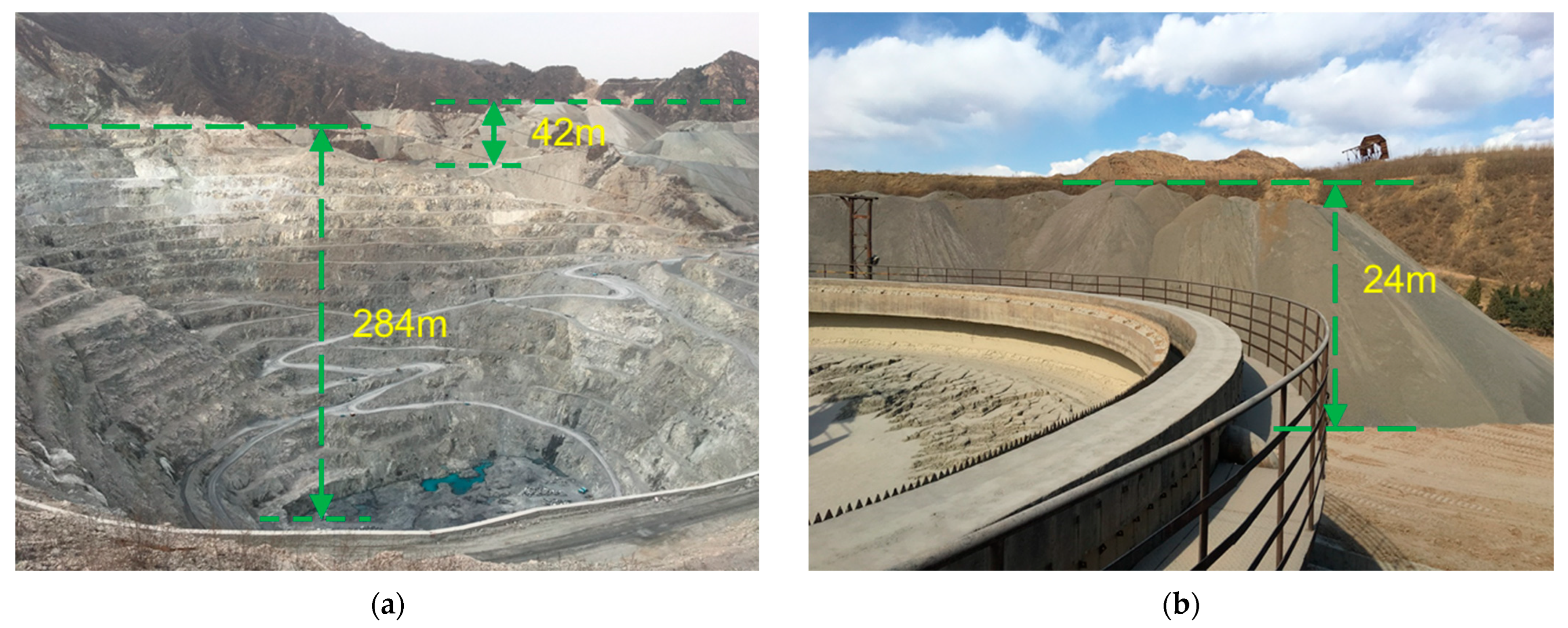
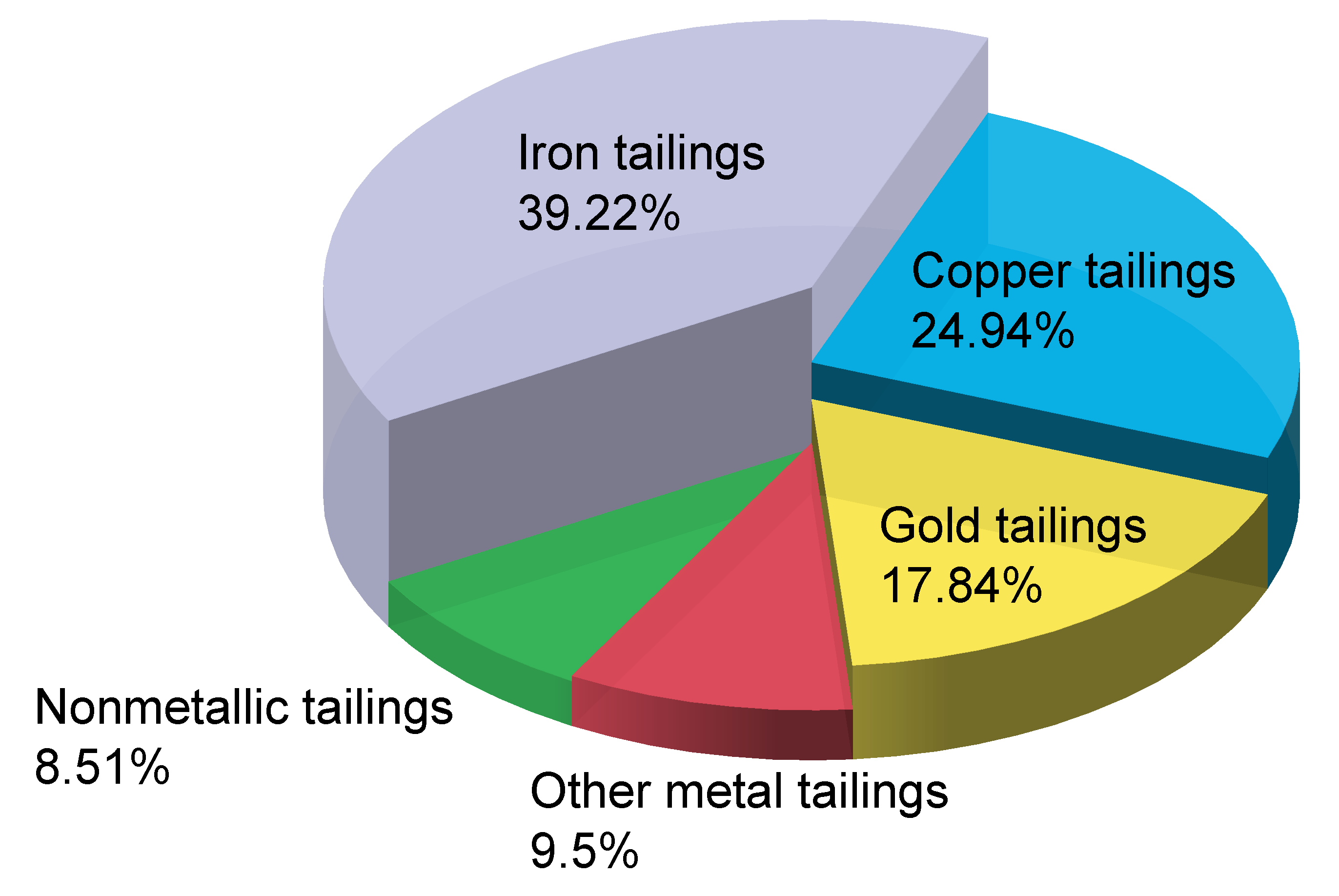
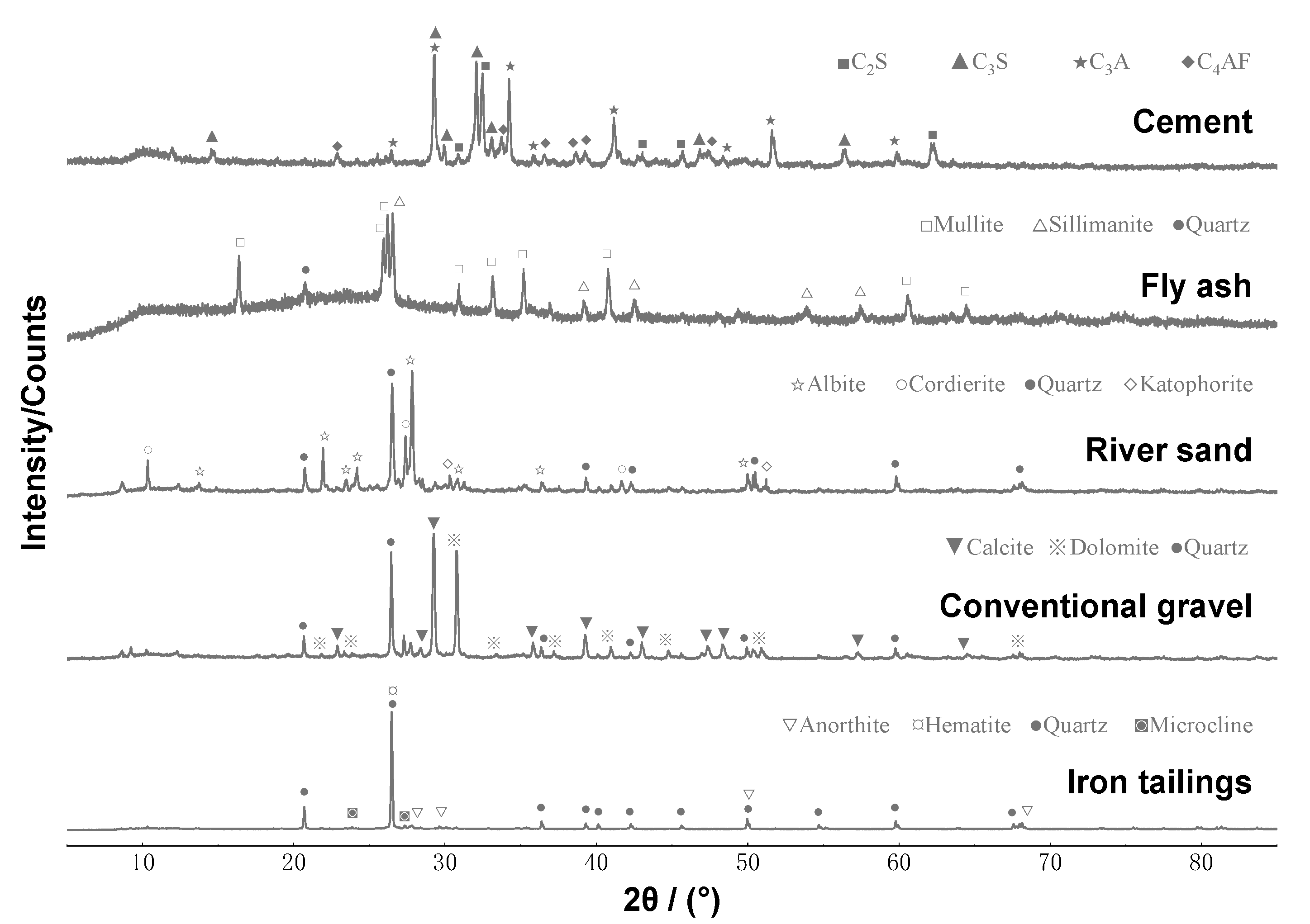
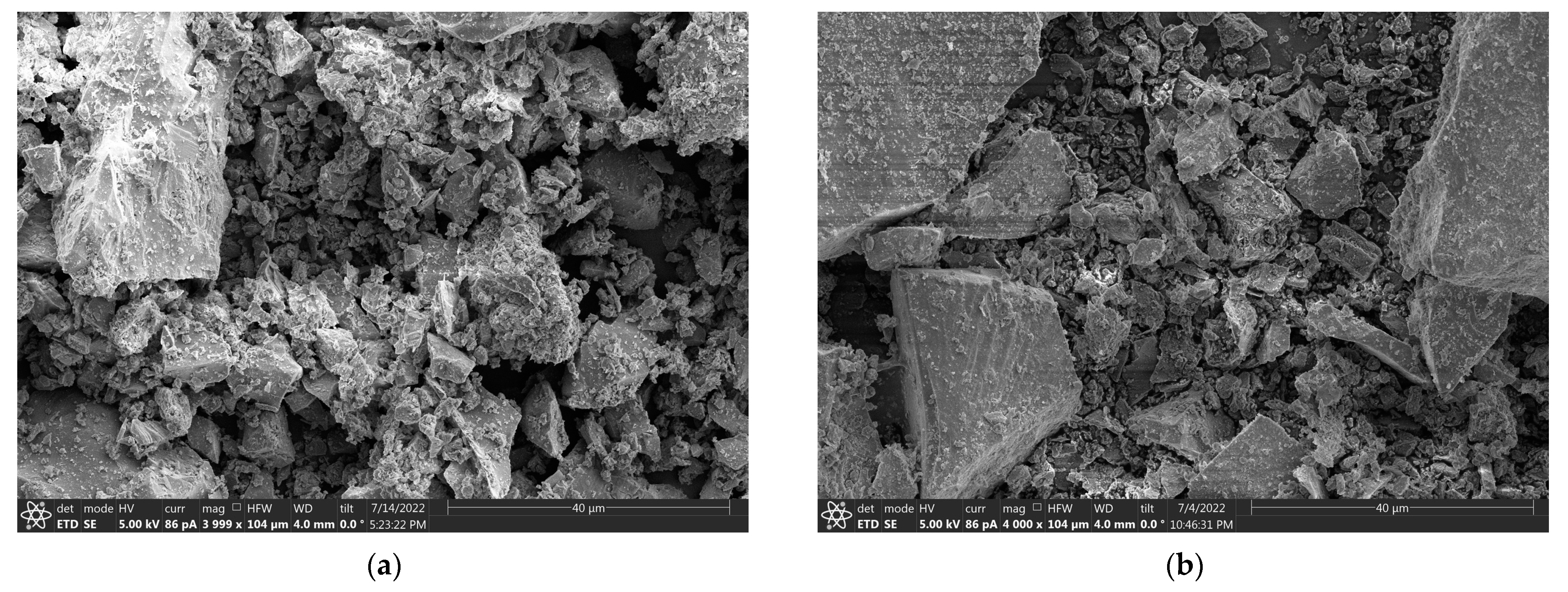


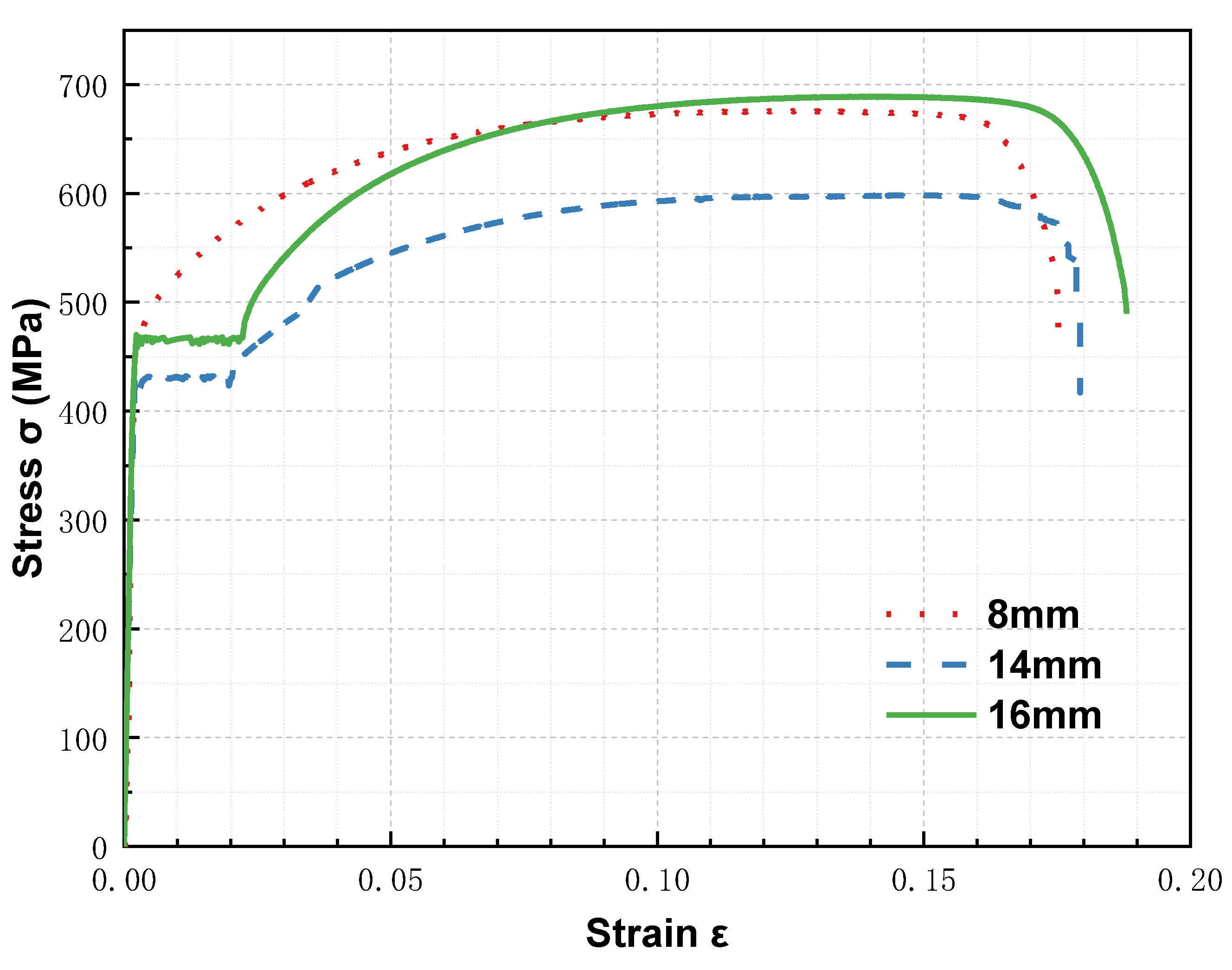
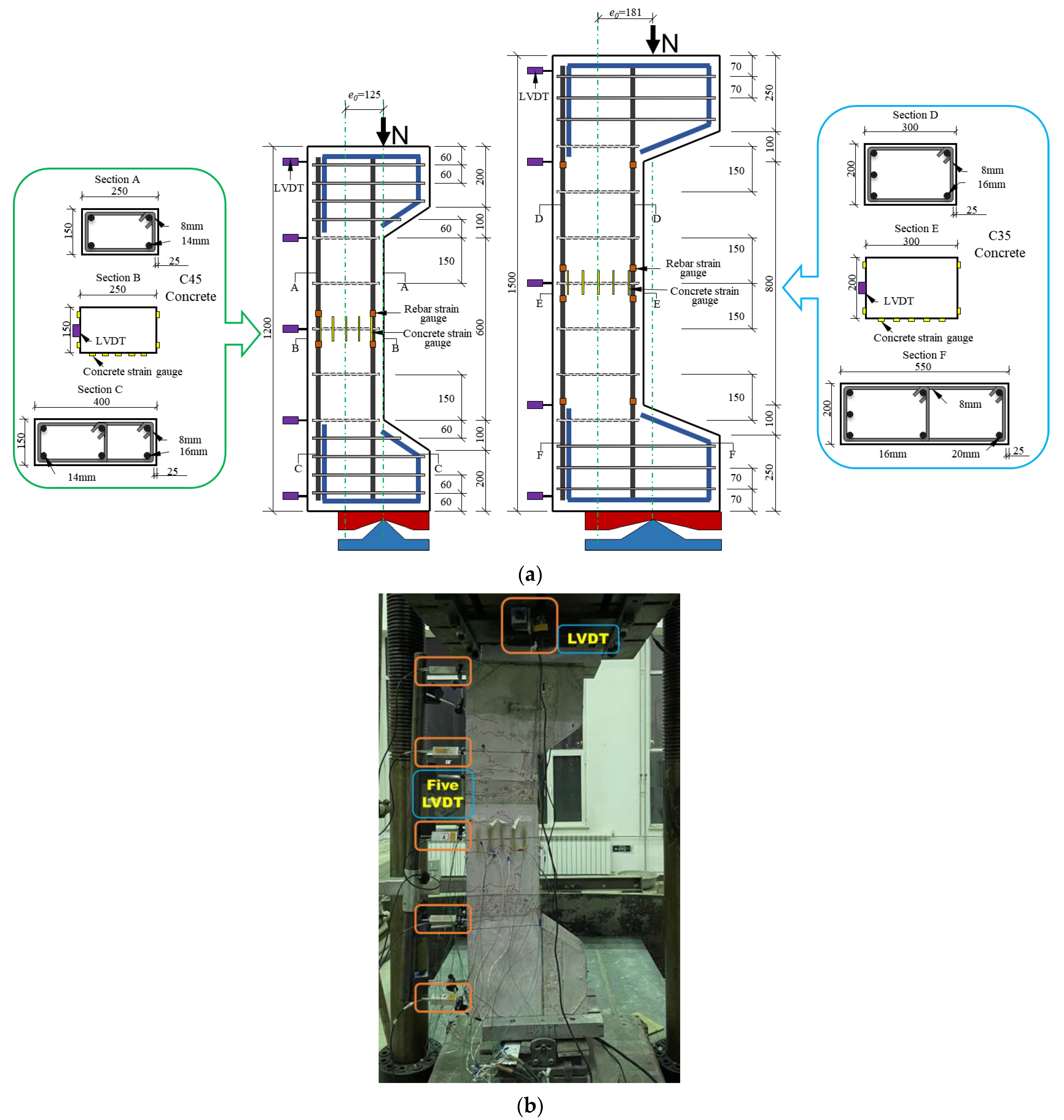

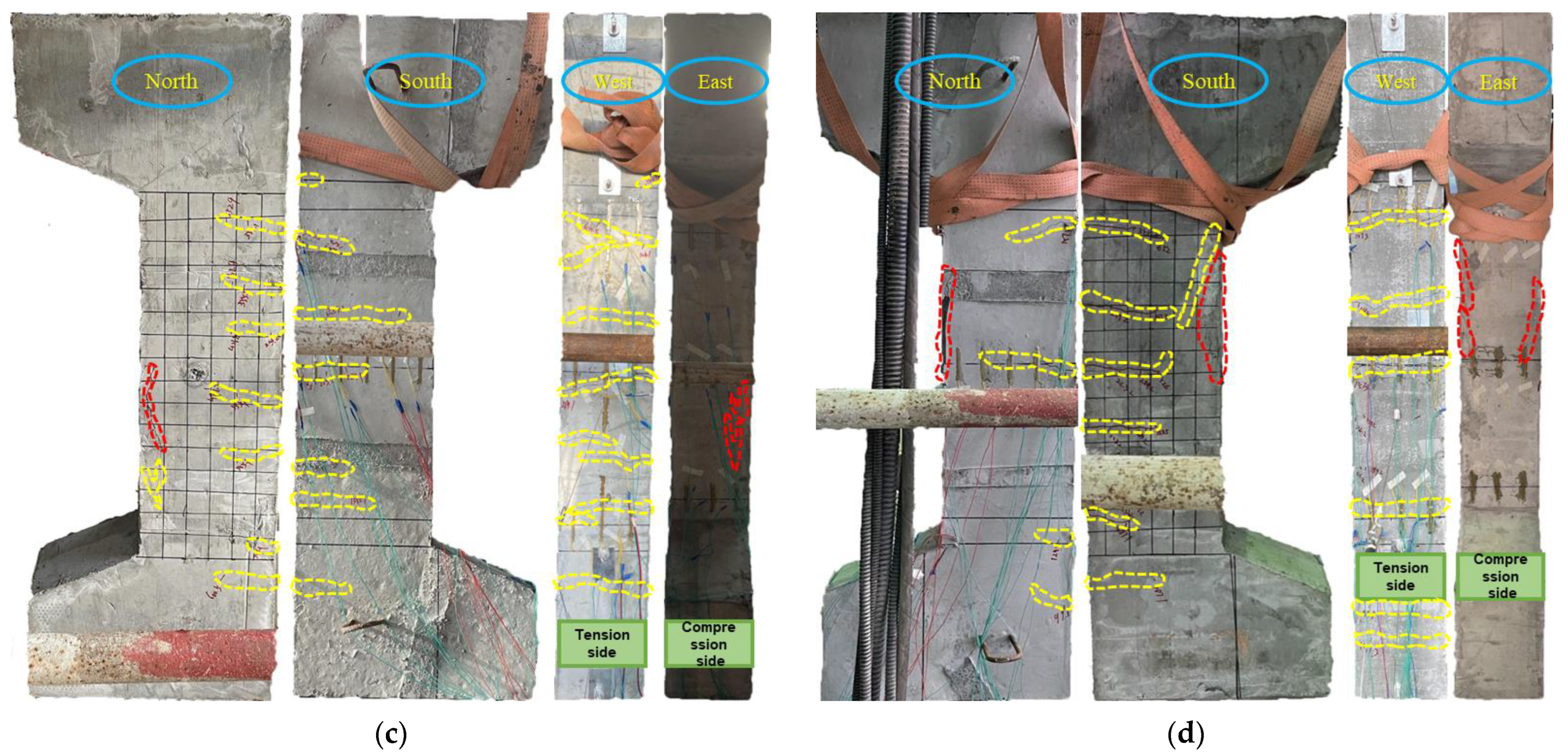
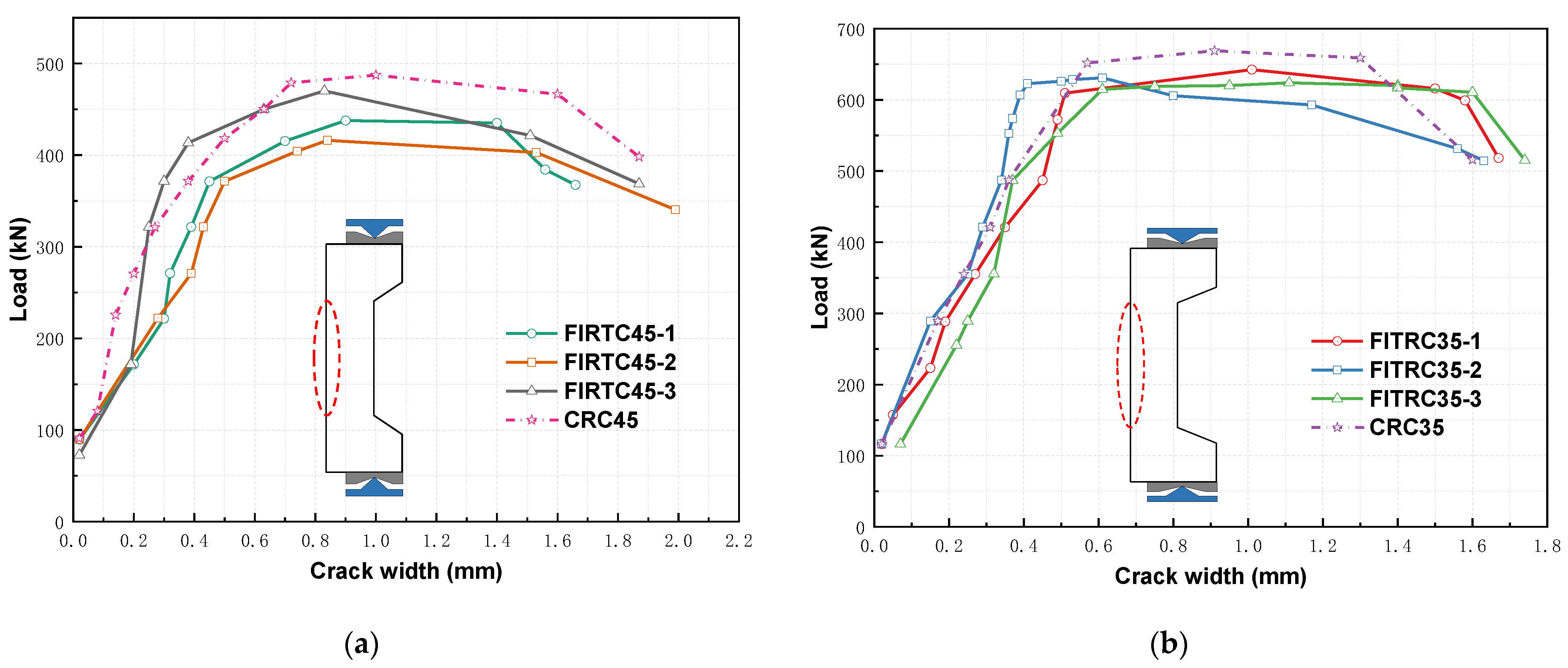
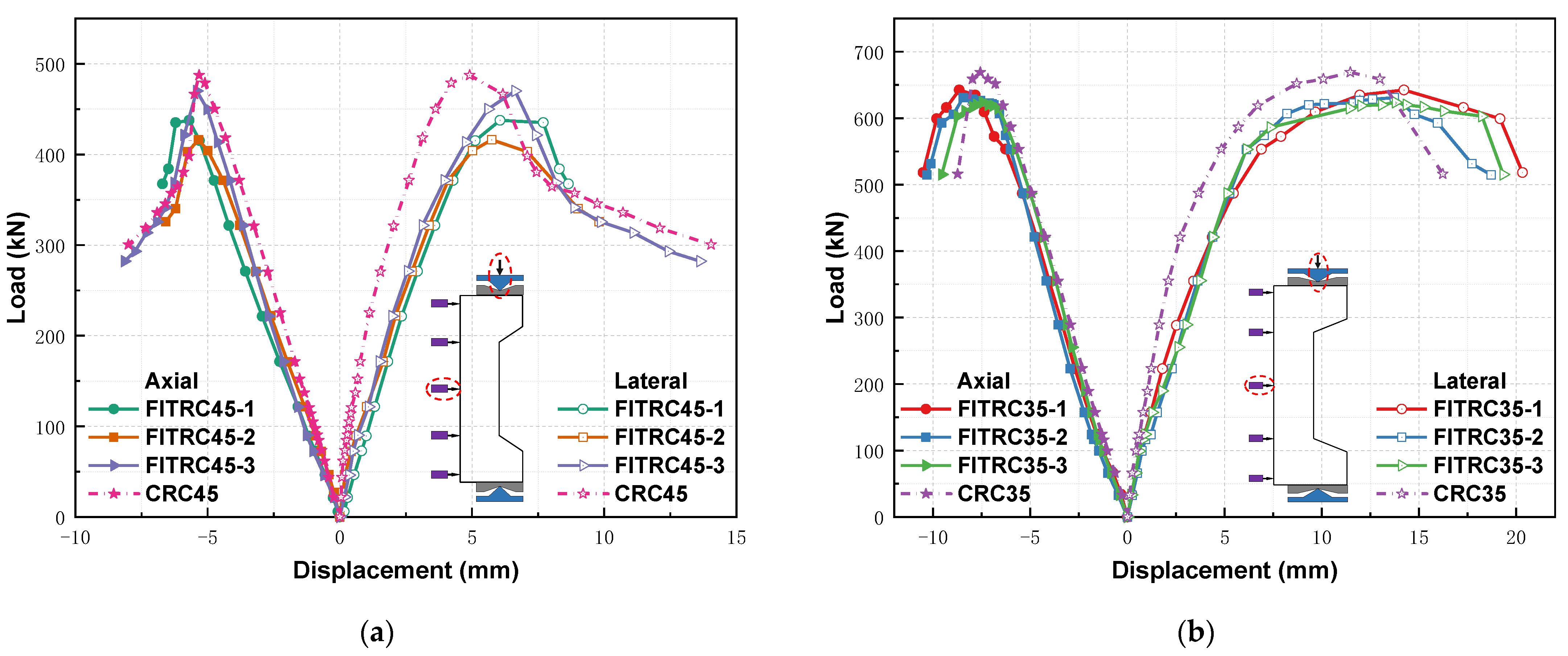
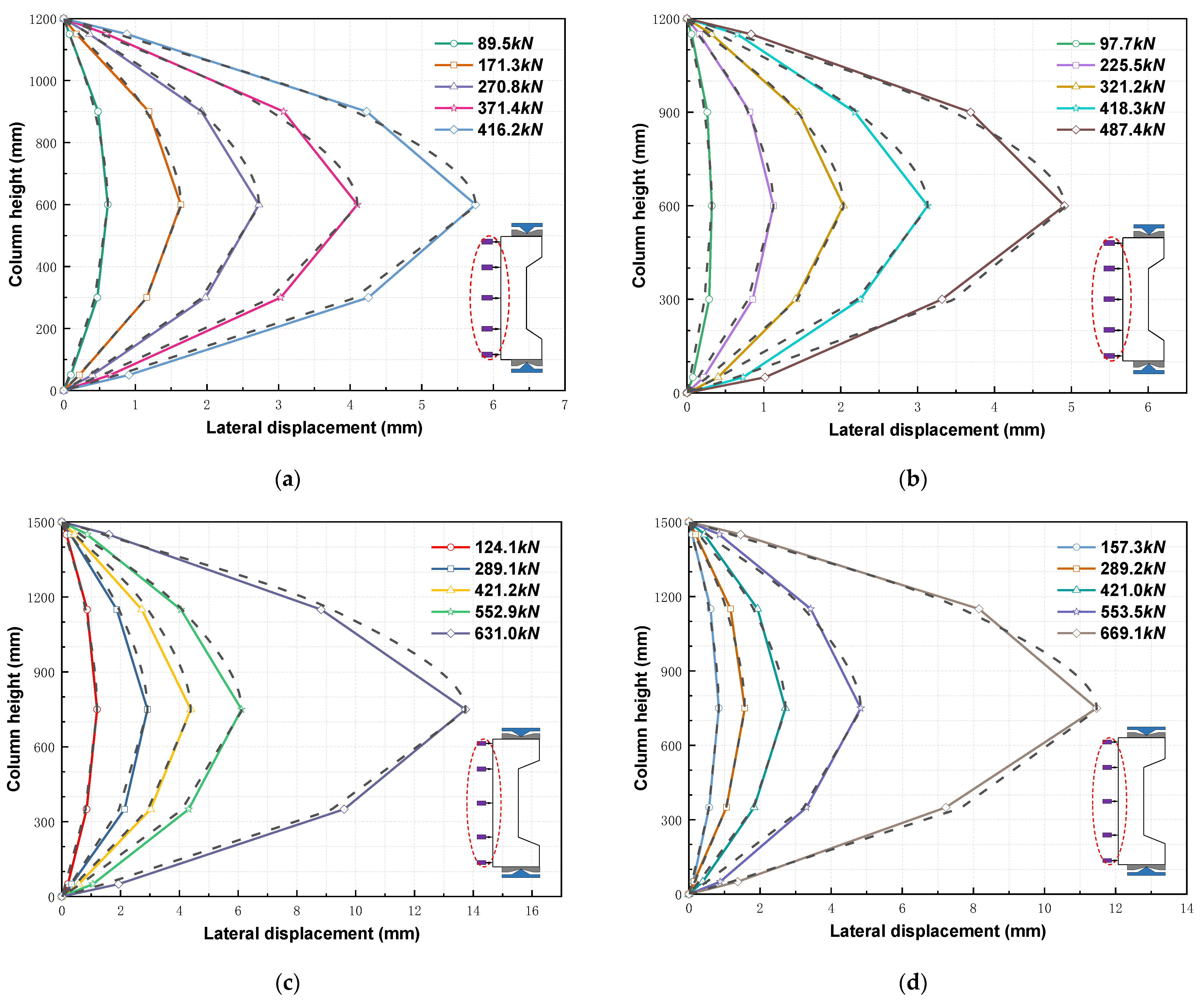
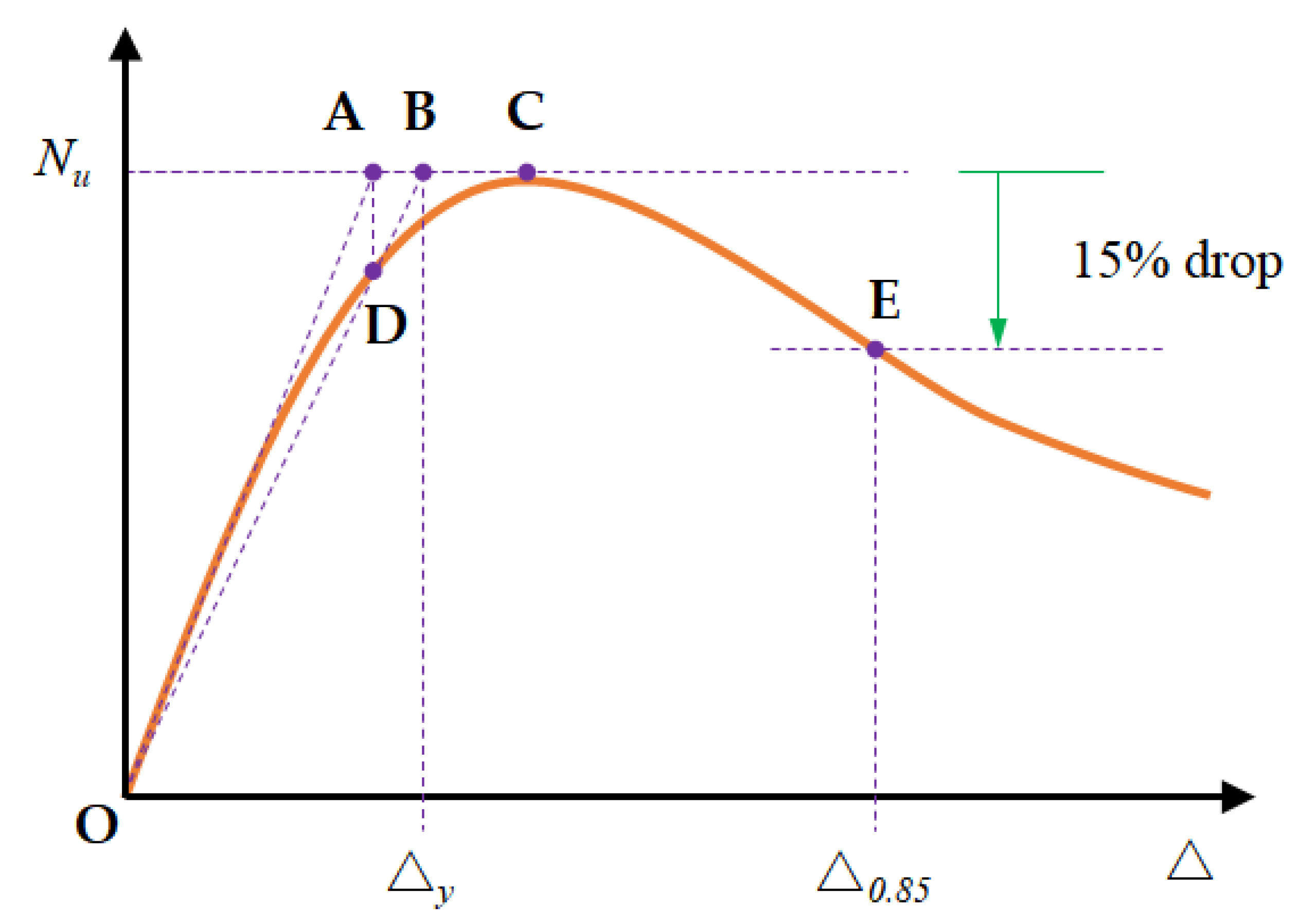
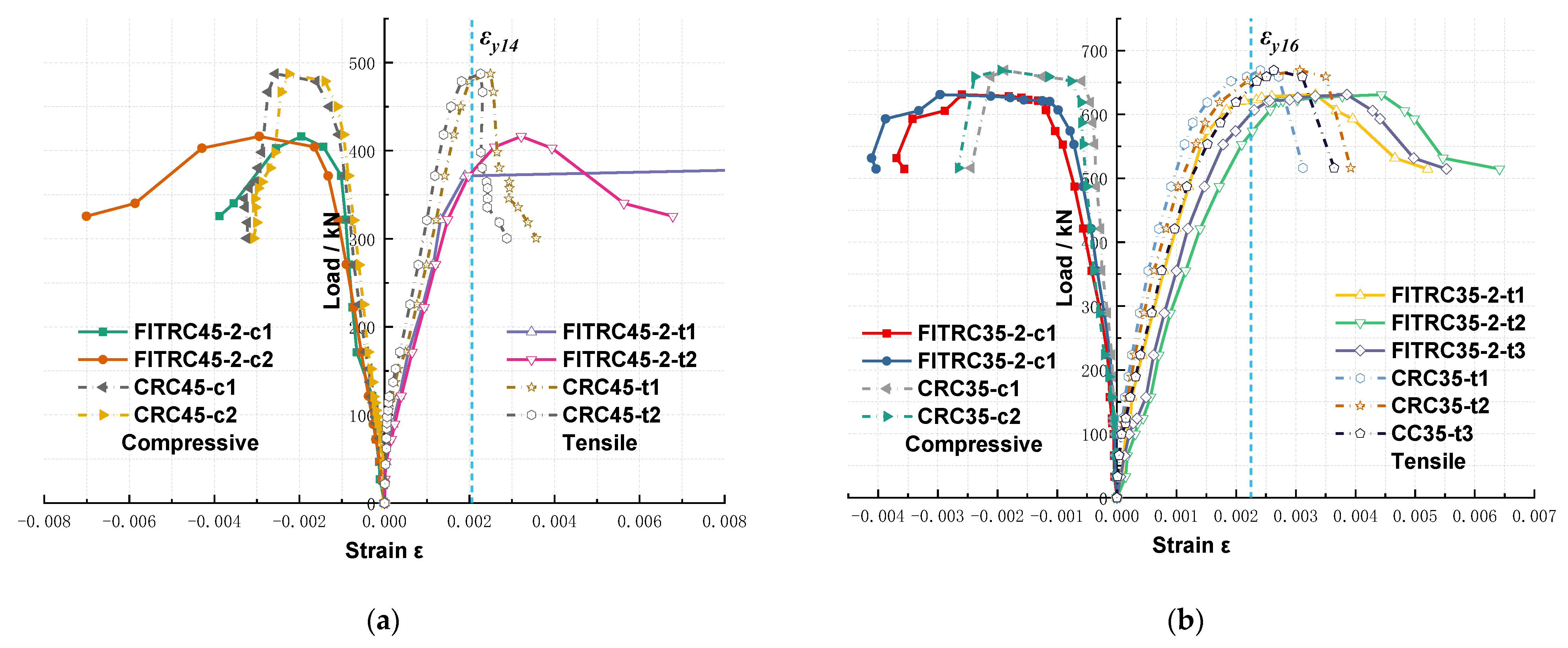
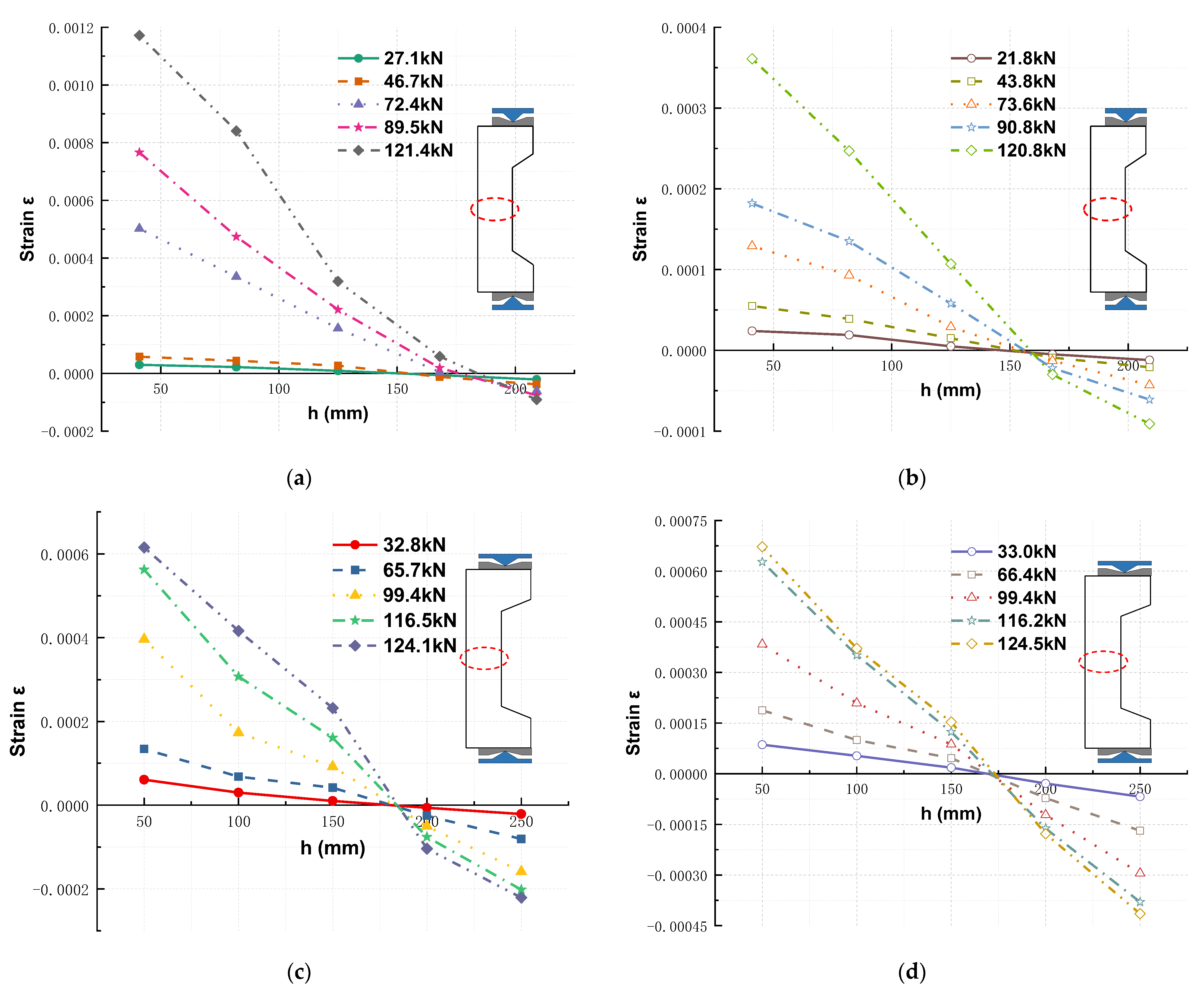

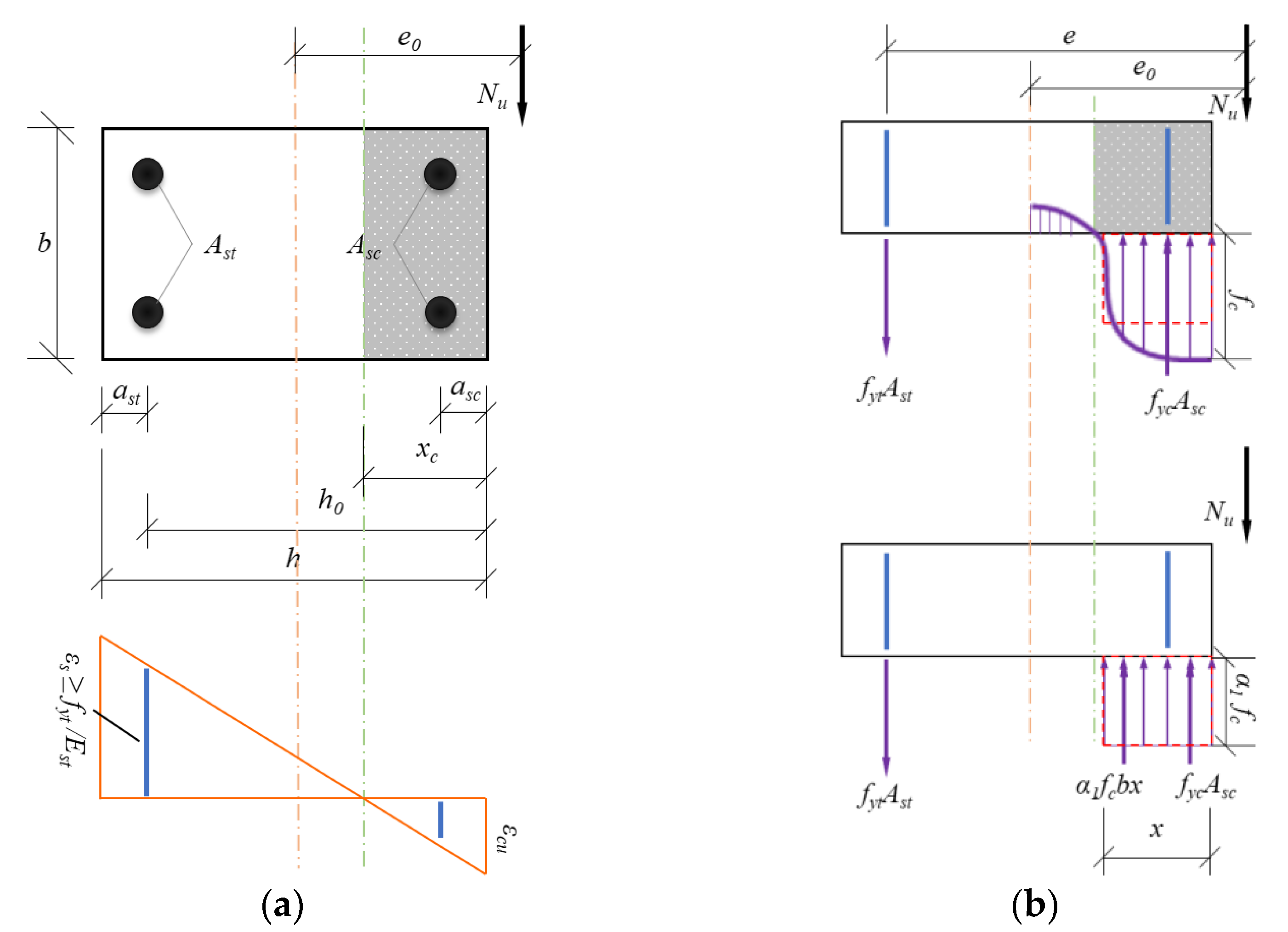
| Specimens | SiO2 | Fe2O3 | MgO | Al2O3 | CaO | CaCO3 |
|---|---|---|---|---|---|---|
| Iron tailings | 68.2% | 12.5% | 6.8% | 5.1% | 4.8% | 0.0% |
| Fly ash | 52.2% | 5.6% | 1.3% | 26.5% | 4.2% | 0.0% |
| River sand | 44.0% | 3.3% | 16.0% | 6.4% | 27.5% | 0.0% |
| Conventional gravel | 15.0% | 0.3% | 16.2% | 0.2% | 0.0% | 68.1% |
| Apparent Density | Flexural Strength (MPa) | Compressive Strength (MPa) | ||
|---|---|---|---|---|
| (kg·m−3) | 3 d | 28 d | 3 d | 28 d |
| 3090 | 6.9 | 10.8 | 31.2 | 52.7 |
| Specimens | D10 (μm) | D50 (μm) | D90 (μm) | SSA (m2·kg−1) | AD (m2·kg−1) |
|---|---|---|---|---|---|
| Iron tailings powder | 1.51 | 15.51 | 74.84 | 480.6 | 2770 |
| Conventional gravel | 3.02 | 26.51 | 98.18 | 415.1 | 2180 |
| Specimens | Compressive Strength of Rock (MPa) | Crushing Index (%) | Soundness (%) | Alkali–Aggregate Reaction (%) | AD (m2·kg−1) | BD (kg·m−3) |
|---|---|---|---|---|---|---|
| Iron tailings gravel | 62.2 | 6.05 | 3.5 | 0.051 | 2730 | 1570 |
| Conventional gravel | 60.0 | 6.56 | 3.7 | 0.042 | 2700 | 1550 |
| Specimens | Water Binder Ratio | Water (kg) | Cement (kg) | Iron Tailings Powder (kg) | Iron Tailings Sand (kg) | Iron Tailings Gravel (kg) | Fly Ash (kg) | River Sand (kg) | Conventional Gravel (kg) | Water Reducing Agent (kg) | Slump (mm) | Dispersion (mm) |
|---|---|---|---|---|---|---|---|---|---|---|---|---|
| FITC45 | 0.32 | 170 | 369 | 158 | 739 | 1017 | - | - | - | 3.1 | 210 | 520 × 530 |
| CC45 | 0.32 | 170 | 369 | - | - | - | 158 | 706 | 976 | 3.1 | 200 | 470 × 490 |
| FITC35 | 0.40 | 170 | 301 | 129 | 775 | 1071 | - | - | - | 2.5 | 215 | 515 × 535 |
| CC35 | 0.40 | 170 | 301 | - | - | - | 129 | 746 | 1031 | 2.5 | 205 | 475 × 490 |
| Specimens | Cubic Compressive Strength fcu (MPa) | Prismatic Compressive Strength fc (MPa) | Splitting Tensile Strength ft (MPa) | Static Modulus of Elasticity Ec (MPa) | Poisson’s Ratio ν |
|---|---|---|---|---|---|
| FITC45 | 53.5 | 38.1 | 3.5 | 3.22 × 104 | 0.27 |
| CC45 | 55.9 | 41.4 | 3.7 | 3.98 × 104 | 0.24 |
| FITC35 | 44.4 | 34.8 | 3.2 | 3.05 × 104 | 0.25 |
| CC35 | 47.8 | 36.3 | 3.4 | 3.74 × 104 | 0.23 |
| Reinforcement Diameter (mm) | Yield Strength fy (MPa) | Ultimate Strength fu (MPa) | Elastic Modulus Es (MPa) | Percentage Elongation after Fracture (%) |
|---|---|---|---|---|
| 8 | 460 | 676 | 2.06 × 104 | 17.2 |
| 14 | 430 | 598 | 2.09 × 104 | 19.0 |
| 16 | 466 | 689 | 2.07 × 104 | 20.3 |
| Specimens | Nu (kN) | Δp (mm) | Δy (mm) | Δ0.85 (mm) | μ | λ |
|---|---|---|---|---|---|---|
| FITRC45-1 | 437.7 | 6.06 | 5.23 | 8.04 | 1.54 | 1.33 |
| FITRC45-2 | 416.2 | 5.75 | 4.00 | 8.58 | 2.15 | 1.49 |
| FITRC45-3 | 470.1 | 6.63 | 4.71 | 7.75 | 1.65 | 1.17 |
| CRC45 | 487.4 | 4.91 | 2.46 | 6.89 | 2.80 | 1.40 |
| FITRC35-1 | 642.5 | 14.23 | 6.62 | 19.80 | 2.99 | 1.39 |
| FITRC35-2 | 631.0 | 13.73 | 6.72 | 17.32 | 2.58 | 1.26 |
| FITRC35-3 | 624.0 | 13.80 | 6.60 | 19.17 | 2.90 | 1.39 |
| CRC35 | 669.1 | 11.46 | 4.28 | 15.02 | 3.51 | 1.31 |
| Specimens | Ncr (kN) | Nu (kN) | Ncr-t (kN) | Nu-t (kN) | ||
|---|---|---|---|---|---|---|
| FITRC45-1 | 89.5 | 437.7 | 85.3 | 405.2 | 1.05 | 1.08 |
| FITRC45-2 | 89.5 | 416.2 | 85.3 | 405.2 | 1.05 | 1.03 |
| FITRC45-3 | 90.3 | 470.1 | 85.3 | 405.2 | 1.06 | 1.16 |
| CRC45 | 90.8 | 487.4 | 86.8 | 418.6 | 1.05 | 1.16 |
| FITRC35-1 | 116.5 | 642.5 | 110.8 | 598.9 | 1.05 | 1.07 |
| FITRC35-2 | 116.5 | 631.0 | 110.8 | 598.9 | 1.05 | 1.05 |
| FITRC35-3 | 116.3 | 624.0 | 110.8 | 598.9 | 1.05 | 1.04 |
| CRC35 | 116.2 | 669.1 | 111.9 | 608.4 | 1.04 | 1.10 |
| Specimens | Nu (kN) | Δp (mm) | η | M1 (kN·m) | M2 (kN·m) | Mmax (kN·m) | |
|---|---|---|---|---|---|---|---|
| FITRC45-1 | 437.7 | 6.06 | 1.048 | 54.7 | 2.7 | 57.4 | 1.11 |
| FITRC45-2 | 416.2 | 5.75 | 1.046 | 52.0 | 2.4 | 54.4 | 1.00 |
| FITRC45-3 | 470.1 | 6.63 | 1.053 | 58.8 | 3.1 | 61.9 | 1.30 |
| CRC45 | 487.4 | 4.91 | 1.039 | 60.9 | 2.4 | 63.3 | 1.00 |
| FITRC35-1 | 642.5 | 14.23 | 1.079 | 116.3 | 9.1 | 125.4 | 1.19 |
| FITRC35-2 | 631.0 | 13.73 | 1.076 | 114.2 | 8.7 | 122.9 | 1.13 |
| FITRC35-3 | 624.0 | 13.80 | 1.076 | 112.9 | 8.6 | 121.6 | 1.12 |
| CRC35 | 669.1 | 11.46 | 1.063 | 121.1 | 7.7 | 128.8 | 1.00 |
Disclaimer/Publisher’s Note: The statements, opinions and data contained in all publications are solely those of the individual author(s) and contributor(s) and not of MDPI and/or the editor(s). MDPI and/or the editor(s) disclaim responsibility for any injury to people or property resulting from any ideas, methods, instructions or products referred to in the content. |
© 2023 by the authors. Licensee MDPI, Basel, Switzerland. This article is an open access article distributed under the terms and conditions of the Creative Commons Attribution (CC BY) license (https://creativecommons.org/licenses/by/4.0/).
Share and Cite
Ma, X.; Sun, J.; Zhang, F.; Yuan, J.; Yang, M.; Meng, Z.; Bai, Y.; Liu, Y. Mechanical Behaviour Evaluation of Full Iron Tailings Concrete Columns under Large Eccentric Short-Term Loading. Materials 2023, 16, 2466. https://doi.org/10.3390/ma16062466
Ma X, Sun J, Zhang F, Yuan J, Yang M, Meng Z, Bai Y, Liu Y. Mechanical Behaviour Evaluation of Full Iron Tailings Concrete Columns under Large Eccentric Short-Term Loading. Materials. 2023; 16(6):2466. https://doi.org/10.3390/ma16062466
Chicago/Turabian StyleMa, Xinxin, Jianheng Sun, Fengshuang Zhang, Jing Yuan, Mingjing Yang, Zhiliang Meng, Yongbing Bai, and Yunpeng Liu. 2023. "Mechanical Behaviour Evaluation of Full Iron Tailings Concrete Columns under Large Eccentric Short-Term Loading" Materials 16, no. 6: 2466. https://doi.org/10.3390/ma16062466
APA StyleMa, X., Sun, J., Zhang, F., Yuan, J., Yang, M., Meng, Z., Bai, Y., & Liu, Y. (2023). Mechanical Behaviour Evaluation of Full Iron Tailings Concrete Columns under Large Eccentric Short-Term Loading. Materials, 16(6), 2466. https://doi.org/10.3390/ma16062466






